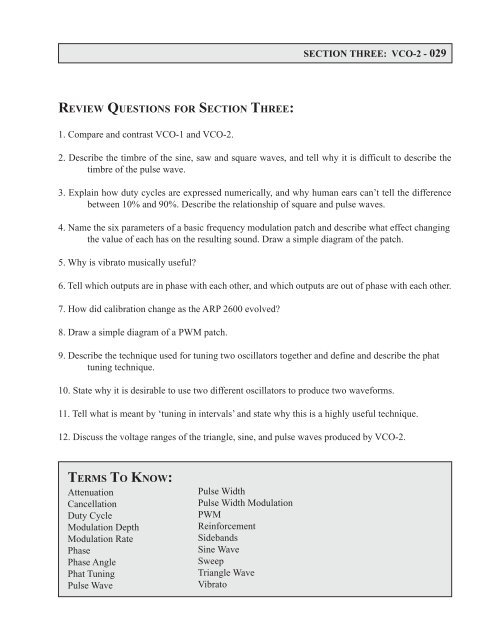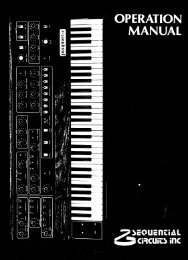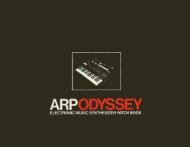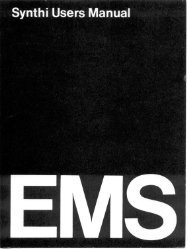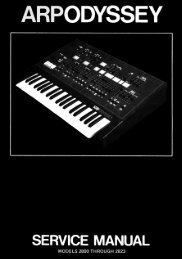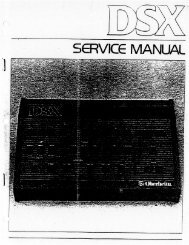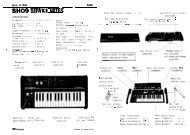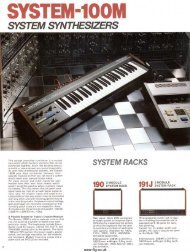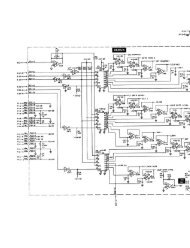- Page 3 and 4: Secret Society ProductionsFundament
- Page 5 and 6: TABLE OF CONTENTSTable of Contents.
- Page 7 and 8: CD TRACK LISTINGTrack Page Note(s)
- Page 10 and 11: CD TRACK LISTINGTrack Page Note(s)
- Page 12 and 13: PREFACEto the first editionThis boo
- Page 14 and 15: THANK YOUThis book is and has been
- Page 16 and 17: SECTION1 GENERAL CONTROLSINTRODUCTI
- Page 18 and 19: RELEASETIMESUSTAINVOLTAGEDECAYTIMEA
- Page 20 and 21: SECTION ONE: GENERAL CONTROLS - 005
- Page 22 and 23: SECTION ONE: GENERAL CONTROLS - 007
- Page 24 and 25: SECTION ONE: GENERAL CONTROLS - 009
- Page 26 and 27: SECTION2 VCO-1ALL ABOUT OSCILLATORS
- Page 28 and 29: SECTION TWO: VCO-1 - 013MODULATION:
- Page 30 and 31: SECTION TWO: VCO-1 - 015KBDCVOUTPUT
- Page 32 and 33: SECTION TWO: VCO-1 - 017REVIEW QUES
- Page 34 and 35: SECTION THREE: VCO-2 - 019NOT JUST
- Page 36 and 37: SECTION THREE: VCO-2 - 021A NOTE AB
- Page 38 and 39: SECTION THREE: VCO-2 - 023THE BLACK
- Page 40 and 41: SECTION THREE: VCO-2 - 0251. VCO-1
- Page 42 and 43: SECTION THREE: VCO-2 - 027beats are
- Page 46 and 47: SECTION FOUR: VCO-3 - 031tion, two
- Page 48 and 49: SECTION FOUR: VCO-3 - 033THE MASTER
- Page 50 and 51: SECTION FOUR: VCO-3 - 035REVIEW QUE
- Page 52 and 53: SECTION FIVE: NOISE GENERATOR - 037
- Page 54 and 55: SECTION FIVE: NOISE GENERATOR - 039
- Page 56 and 57: SECTION FIVE: NOISE GENERATOR - 041
- Page 58 and 59: SECTION SIX: VCF - 043This analogy
- Page 60: SECTION SIX: VCF - 045buzzy sound.
- Page 63 and 64: 048 - SECTION SIX: VCFreason for th
- Page 65 and 66: 050 - SECTION SIX: VCFTHE ROLE OF T
- Page 67 and 68: 052 - SECTION SIX: VCFEXPERIMENTS F
- Page 69 and 70: 054 - SECTION SIX: VCFREVIEW QUESTI
- Page 71 and 72: 056 - SECTION SEVEN: ADSR AND AR GE
- Page 73 and 74: 058 - SECTION SEVEN: ADSR AND AR GE
- Page 75 and 76: 060 - SECTION SEVEN: ADSR AND AR GE
- Page 77 and 78: 062 - SECTION SEVEN: ADSR AND AR GE
- Page 79 and 80: 064 - SECTION EIGHT: THE VCATHE VCA
- Page 81 and 82: 066 - SECTION EIGHT: THE VCAOF LAWS
- Page 83 and 84: 068 - SECTION EIGHT: THE VCAEXPERIM
- Page 85 and 86: SECTION9 MIXER SECTIONTHE MIXERThe
- Page 87 and 88: 072 - SECTION NINE: THE MIXER SECTI
- Page 89 and 90: 074 - SECTION NINE: THE MIXER SECTI
- Page 91 and 92: 076 - SECTION TEN: S/H MODULECLOCK
- Page 93 and 94: 078 - SECTION TEN: S/H MODULEYet an
- Page 95 and 96:
080 - SECTION TEN: S/H MODULEEXPERI
- Page 97 and 98:
SECTION11 PREAMP ET ALTHE PREAMPFig
- Page 99 and 100:
084 - SECTION ELEVEN: PREAMP, ENVEL
- Page 101 and 102:
086 - SECTION ELEVEN: PREAMP, ENVEL
- Page 103 and 104:
088 - SECTION ELEVEN: PREAMP, ENVEL
- Page 105 and 106:
090 - SECTION ELEVEN: PREAMP, ENVEL
- Page 107 and 108:
092 - SECTION TWELVE: VOLTAGE PROCE
- Page 109 and 110:
094 - SECTION TWELVE: VOLTAGE PROCE
- Page 111 and 112:
096 - SECTION TWELVE: VOLTAGE PROCE
- Page 113 and 114:
SECTION13KEYBOARD CONTROLSA KEYBOAR
- Page 115 and 116:
100 - SECTION THIRTEEN: KEYBOARD CO
- Page 117 and 118:
102 - SECTION THIRTEEN: KEYBOARD CO
- Page 119 and 120:
104 - SECTION THIRTEEN: KEYBOARD CO
- Page 121 and 122:
106 - SECTION THIRTEEN: KEYBOARD CO
- Page 123 and 124:
108 - SECTION THIRTEEN: KEYBOARD CO
- Page 125 and 126:
110 - SECTION FOURTEEN: PATCH DIAGR
- Page 127 and 128:
SUSTAIN RELEASEVOLTAGE TIMEDECAYTIM
- Page 129 and 130:
114 - SECTION FOURTEEN: PATCH DIAGR
- Page 131 and 132:
116 - SECTION FOURTEEN: PATCH DIAGR
- Page 133 and 134:
118 - SECTION FOURTEEN: PATCH DIAGR
- Page 135 and 136:
120 - SECTION FIFTEEN: THE ARP SEQU
- Page 137 and 138:
122 - SECTION FIFTEEN: THE ARP SEQU
- Page 139 and 140:
124 - SECTION FIFTEEN: THE ARP SEQU
- Page 141 and 142:
126 - GLOSSARYATTENUATION - The act
- Page 143 and 144:
128 - GLOSSARYENVELOPE FOLLOWER - A
- Page 145 and 146:
130 - GLOSSARYLINEAR TO EXPONENTIAL
- Page 147 and 148:
132 - GLOSSARYPOLYPHONIC - A musica
- Page 149 and 150:
134 - GLOSSARYSUPERSONIC - A tone w
- Page 151 and 152:
INDEXAADSR 57Amplitude Modulation 8
- Page 153 and 154:
BIBLIOGRAPHYColbeck, Julian. Keyfax
- Page 155 and 156:
Appendix One:ADDITIONAL RESOURCESBO
- Page 157 and 158:
142 - ADDITIONAL RESOURCESYamaha Sy
- Page 159 and 160:
144
- Page 161:
BY USING THIS CD, YOU INDICATE YOUR


